|
|
|
Sort Order |
|
|
|
Items / Page
|
|
|
|
|
|
|
| Srl | Item |
| 1 |
ID:
120207
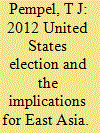

|
|
|
|
|
| Publication |
2013.
|
| Summary/Abstract |
The 2012 election resulted in a major victory for President Obama and while his Democratic Party improved its Congressional strength, the House of Representatives remains under Republican control. The election revealed the depth of America's political and voter divisions with each party showing dramatically different areas of strength and weakness. Yet the election did not hinge on foreign policy leaving the Obama administration likely to continue most of its earlier policies toward East Asia as marked by the multilayered 'pivot' toward Asia. Relations with China and North Korea are likely to remain difficult to manage while US-ROK links should be far smoother. Of particular concern is the economic sluggishness and rising nationalism in Japan which could well cause bilateral problems with the US and regional problems with Japan's neighbors, including US ally, South Korea. And at home the bipolar divisions over how best to deal with America's economic revitalization could well impede US abilities to exert a convincing multi-dimensional role in the region.
|
|
|
|
|
|
|
|
|
|
|
|
|
|
|
|
| 2 |
ID:
130619
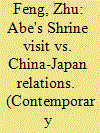

|
|
|
| 3 |
ID:
128428
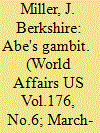

|
|
|
|
|
| Publication |
2014.
|
| Summary/Abstract |
China's aggressive actions in the East China Sea, combined with other factors, especially North Korea's continuing intransigence, have created an increasingly hostile security environment for Japan. Its response to these events can be seen in the impressive political rebirth of Shinzo Abe and the Liberal Democratic Party. While Abe, currently serving as prime minister for a second time, was elected largely because of his economic policies and the ineptitude of the formerly ruling Democratic Party of Japan, he has used his mandate to press forward with long needed, albeit controversial, defense and security reforms that indicate the seriousness with which Tokyo takes its current situation. With China looming up in front of them, and Pyongyang posing lesser but still worrisome threats, the Japanese have become acutely aware of the fact that their Self-Defense Forces (SDF) have one hundred and forty thousand ground troops, one hundred and forty-one maritime vessels, and four hundred and ten aircraft, while China's People's Liberation Army has one million six hundred thousand troops and North Korea has one million soldiers. Meanwhile, North Korea maintains a significant, if decaying, navy and air force, with one hundred and ninety vessels and approximately six hundred aircraft. China's much more capable maritime and air assets include nine hundred and seventy vessels and two thousand five hundred and eighty aircraft.
|
|
|
|
|
|
|
|
|
|
|
|
|
|
|
|
| 4 |
ID:
126305
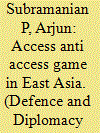

|
|
|
|
|
| Summary/Abstract |
The East Asian theatre is emerging as a region where there are frequent military confrontations. The territorial disputes are the pivot of all recent tensions in the region. China, backed by its increasing economic and military might, is turning more assertive in its claims. The dispute might be regional but any military flare up has few changes of being limited to the regional players. This is because of the security architecture in the region, in which the United States in an important external actor. This is a cause of major concern for China, particularly in the event of a possible non-pacific reunification of Taiwan with the Chinese Mainland or a war with Japan over the island dispute. At present, the US is the only power that could challenge the Chinese military supremacy in the region. Back in the 1996 Taiwan Crisis, the US had deployed two of its aircraft carriers as a signal to China of its resolve to maintain the status quo in the region. Ever since, China began to develop an Anti-Access and Area Denial (A2/ AD) strategy with the sole aim of preventing the US military from intervening in any conflict in the region involving China. This paper looks at the Chinese and US military Strategies that are involving in the region. Specific focus in given to the people`s Liberation Army Air Force bomber Aircraft force which has been modified to fire long range Air Launched Cruise Missile (ALCMs) to threaten the US military bases around China, and the future measures that the PLA might take to deny access to US forces in the region.
|
|
|
|
|
|
|
|
|
|
|
|
|
|
|
|
| 5 |
ID:
053817
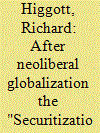

|
|
|
| 6 |
ID:
138470
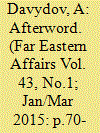

|
|
|
|
|
| Summary/Abstract |
The subject of the round table is quite timely. It is all the more important inasmuch as the assessment of the situation in East Asia given in reports and statements of experts and mass media representatives of various countries, not only foreign, but also Russian, are often based not so much on an analysis of actions of these countries, as on certain initiatives and expressions of their politicians, which sometimes have a too emotional, if not propaganda or provocative, character.
|
|
|
|
|
|
|
|
|
|
|
|
|
|
|
|
| 7 |
ID:
128922
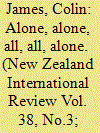

|
|
|
| 8 |
ID:
107781
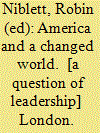

|
|
|
|
|
| Publication |
London, Wiley-Blackwell, 2010.
|
| Description |
xiii, 282p.
|
| Standard Number |
9781405198455
|
|
|
|
|
|
|
|
|
|
|
|
Copies: C:1/I:0,R:0,Q:0
Circulation
| Accession# | Call# | Current Location | Status | Policy | Location |
| 056293 | 327.73/NIB 056293 | Main | On Shelf | General | |
|
|
|
|
| 9 |
ID:
069595


|
|
|
| 10 |
ID:
053166
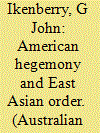

|
|
|
| 11 |
ID:
075093
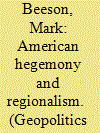

|
|
|
| 12 |
ID:
113160
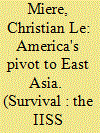

|
|
|
|
|
| Publication |
2012.
|
| Summary/Abstract |
The announcement of a reformed US defence strategy by President Barack Obama and Secretary of Defense Leon Panetta in early January 2012 confirmed a pivot towards the Asia-Pacific as commitments to war fighting in the Middle East and Central Asia subside. Obama, Panetta and General Martin Dempsey, the chairman of the Joint Chiefs of Staff, briefed reporters on 5 January on America's new strategic guidance document, 'Sustaining US Leadership: Priorities for 21st Century Defense'. The product of a review of US defence priorities 'at a moment of transition' for the nation, the document notes that the United States will 'of necessity rebalance toward the Asia-Pacific region'. The principle of the Asia pivot was also signalled by Secretary of State Hillary Clinton in a November 2011 Foreign Policy article in which she noted that 'one of the most important tasks of American statecraft over the next decade will … be to lock in a substantially increased investment - diplomatic, economic, strategic, and otherwise - in the Asia-Pacific region'.
|
|
|
|
|
|
|
|
|
|
|
|
|
|
|
|
| 13 |
ID:
164421
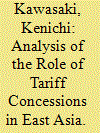

|
|
|
|
|
| Summary/Abstract |
While many studies focus on the impact of trade agreements, the literature has not focused on the extent of their implementation, in terms of the aspects agreed upon therein. In this article, we identify the past achievements of economic partnership agreements (EPAs) in the East Asian region in terms of tariff removals and suggest room for further economic benefits from trade liberalisation in the region. Second, we incorporate the HS6-level tariff concession dataset, which distinguishes between tariff removals agreed in these EPAs in East Asia but not yet implemented, from existing overall tariffs in 2011, in the Global Trade Analysis Project (GTAP) Database, which only incorporates enforced tariff reductions through the base-year applied tariffs. To analyse future trade integration, we include commitments that are not yet implemented. This allows us to analyse partial versus full enforcement of tariff concession commitments. Our results suggest that taking those commitments into account matters economically in East Asia.
|
|
|
|
|
|
|
|
|
|
|
|
|
|
|
|
| 14 |
ID:
107286
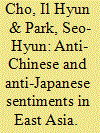

|
|
|
|
|
| Publication |
2011.
|
| Summary/Abstract |
Spanning the presidencies of George W. Bush and Barack Obama, anti-Americanism has become somewhat of a growth industry. Its products are avidly consumed not only in the United States but around the world, often for quite different political purposes. It is not surprising that anti-Americanism plays a large role among traditional enemies of the United States in the Middle East.1 But the same is true of America's allies just across the border, such as Canada and Mexico, and living far apart, such as Australia and New Zealand.2
It would be a big mistake, however, to think that these oppositional sentiments-the complex mixture of opinion, distrust and prejudice-are directed only against America. It plays a role in all parts of the world. Secondary or subordinate states in each world region resent the regional top dog. Such resentment can take various political forms. In Europe, latent anti-German feelings linger, sometimes very close to the surface. When Germany takes a stance against its partners in the European Union, as it has at various times in the unfolding financial crisis, historical anti-German sentiments are quick to appear. Small states in Latin America and Africa also harbour resentment against the self-proclaimed leadership roles of Brazil and Nigeria. And in the Middle East, cross currents of nationalism and religion generate different kinds of political resentment.
East Asia is no exception to this generalization. A large literature focuses on the role of history in shaping the region's current political fault lines. Even minor political crises of the day reveal lingering, deep resentments. In sharp contrast to Europe, however, painful historical memories continue to shape directly, even to provoke, current political crises. This is one important reason why, in a world of regions, East Asia differs from Europe.3 The heavy hand of history, however, has …
|
|
|
|
|
|
|
|
|
|
|
|
|
|
|
|
| 15 |
ID:
176227
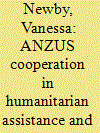

|
|
|
|
|
| Summary/Abstract |
This article discusses how the ANZUS states of United States, Australia, and New Zealand that sit on the fringes of the Asia-Pacific, are increasingly using their armed forces to deliver Humanitarian Aid and Disaster Response (HADR) as a way of engaging with the region. This is a neglected topic both in international relations and research on regional security in the Asia Pacific. This assessment reveals new developments in regional engagement between the ANZUS states and the Asia-Pacific. It finds that despite a shared language, broadly similar regional goals, and a need for interoperability; the ANZUS alliance itself does not appear to be driving closer military coordination on HADR. This article finds instead that HADR is being used to build new informal security networks that combine traditional and non-traditional security threats as a form of soft balancing against China.
|
|
|
|
|
|
|
|
|
|
|
|
|
|
|
|
| 16 |
ID:
077711
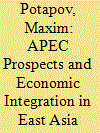

|
|
|
| 17 |
ID:
062525
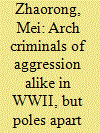

|
|
|
| 18 |
ID:
104352
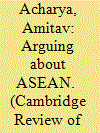

|
|
|
|
|
| Publication |
2011.
|
| Summary/Abstract |
This article argues that ASEAN has been, will remain, an essentially contested institution. No one has claimed, or could claim, that ASEAN is a flawless organization, but at the same time, the characterization of ASEAN as a dysfunctional entity or a talk shop is misplaced. The reality lies in taking the middle ground as the articles in this special issue show. Research and debate on ASEAN should be based on comparing its record with other regional associations in the developing world and using some agreed criteria about what success or failure means. And disagreements about ASEAN's role should be welcomed as part of a healthy debate.
|
|
|
|
|
|
|
|
|
|
|
|
|
|
|
|
| 19 |
ID:
063612
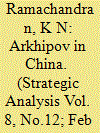

|
|
|
| 20 |
ID:
101999
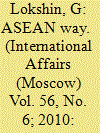

|
|
|
|
|
| Publication |
2010.
|
| Summary/Abstract |
THE PUBLICATION of the book "Bol'shya Vostochnaya Aziya": Mirovaya politika i regional'nye transformatsii. Nauchno-obravovate'nyi kompleks ("Greater East Asia": International Politics and Regional Transformations. Research and Education Handbook. Ed. by A.D. Voskresensky. Moscow, Moscow State Institute (University) of International Relations, 2010, 444 pages) on Greater East Asia (GEA) and the numerous changes taking place in this macroregion is a notable event in Russian political science. The professors and lecturers at the Moscow State Institute (University) of International Relations of the Ministry of Foreign Affairs of the Russian Federation that participated in this collective work called it a "research and education handbook." The book therefore aims to combine strict academic approaches and criteria with new ideas and readability. One should say at once that the book has largely attained its goal - so much so that not just students and experts will find it interesting to read.
|
|
|
|
|
|
|
|
|
|
|
|
|
|
|
|
|
|
|
|
|